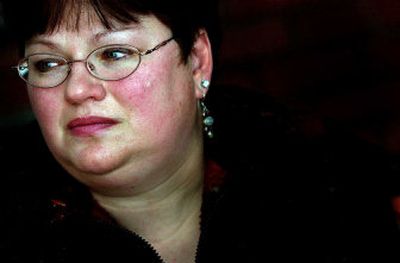Sentenced to loneliness

Keeping the pharmaceutical cocktails straight and dealing with their side effects are bad enough for people with HIV and AIDS.
But it’s the loneliness that’s hardest.
Just ask Vickie Lesley.
Lesley, 44, was diagnosed as HIV-positive in 1995 when she was pregnant with her son. The diagnosis shocked her and her doctor because she was considered low risk. The disease has progressed now to full-blown AIDS.
Lesley, who has lived in a number of states, moved to Coeur d’Alene four years ago with her family to be near friends, but even with friends, North Idaho is a lonely place to have AIDS, said Lesley.
“I felt like there was a part of me where the openness wasn’t as easy, because of repercussions, fear,” said Lesley, who stopped telling people she was infected.
But now, with World AIDS Day approaching on Thursday, Lesley has decided it is time to speak out and dispel notions that AIDS only affects gay men, people in Africa and intravenous drug users.
“More people need to be aware,” she said. “There is no socio-economic, religious definition of who has this.”
Lesley thinks she got the Human Immunodeficiency Virus from her first husband, but she doesn’t know how he got it. She took AZT, the first of the AIDS drugs, while pregnant and her son escaped the disease. Her second husband – her son’s father – is free of the virus.
While AIDS has no cure, it’s now considered a chronic disease – one that can be kept in check with the right combination of drugs. Those who do die from AIDS – estimated at about five people every five minutes worldwide – generally do so from secondary infections a weakened immune system cannot withstand.
Lesley’s first husband, who didn’t know he had the virus until she tested positive, chose not to wait for that end, and killed himself instead in 1997, she said.
Lesley was one of the few people who knew he had AIDS, and she blames the social stigma against people living with HIV and AIDS for making his last days so difficult.
“It’s the loneliness; it’s the total isolation of this disease” that makes it so unbearable, she said.
The North Idaho AIDS Coalition works with a population of about 40 HIV/AIDS patients in the five northern counties, helping them access affordable medications, medical care, housing and mental health services.
“People who are living with this illness are just like you and me, but the majority of them have to live in secrecy because of the stigma,” said Kimberly Peterson, an intern with NIAC.
Peterson believes the actual number of people with HIV or AIDS in North Idaho is probably much higher than their caseload indicates. The growing use of needles among methamphetamine addicts and a general attitude that the disease isn’t a problem here increase the risks, Peterson said.
“Just because people aren’t dropping like flies like they were in the ‘80s doesn’t mean it’s not there,” she said.
And while the caseload isn’t huge, it’s almost more than NIAC can handle since much of the federal funding that supports its work dried up in the aftermath of Sept. 11 terrorist attacks. NIAC now has one caseworker who assists its 40-some clients and no money for prevention work.
Education is sorely needed, said Lesley, who has a nursing degree.
For instance, Lesley – who’s separated from her second husband – was dating a man recently who broke off the relationship because he had a cavity and feared getting HIV from kissing her.
“I’ve actually had family members ask me to bring food in plastic bags,” because they’re afraid of eating what she’s touched, she said.
When Lesley was diagnosed 10 years ago, AIDS was a death sentence. She made the modest goal of living until her son graduates from high school. Now she has another goal: to raise awareness and acceptability of HIV/AIDS to the same level as breast cancer.
“We’ve got to start seeing these shirts around,” she said, holding up a World AIDS Day 2005 T-shirt she had printed for the occasion.